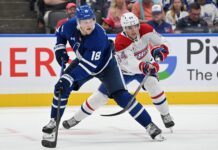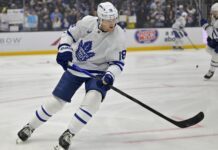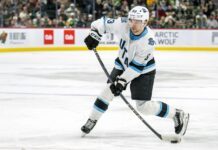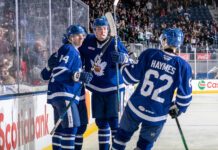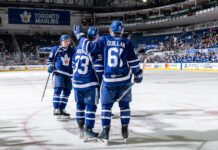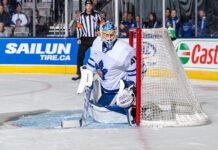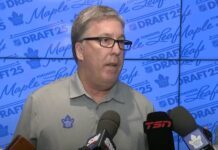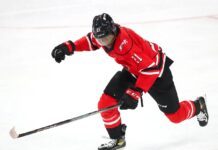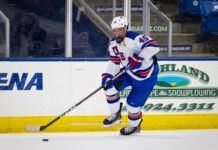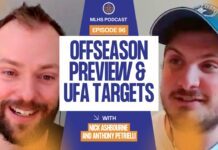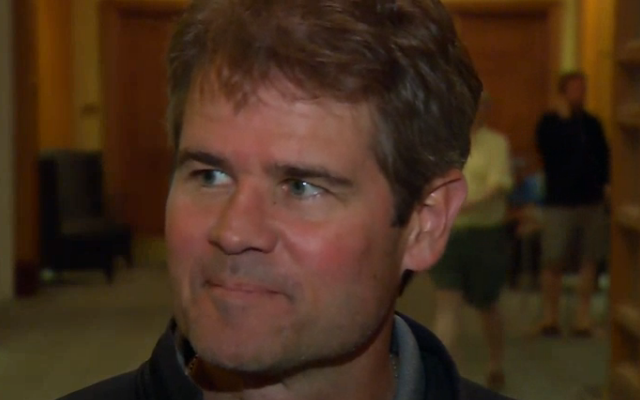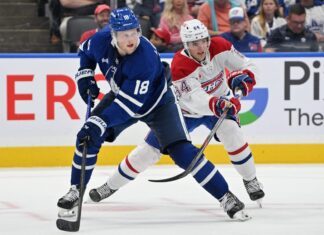Alec Brownscombe caught up with Director of Player Development Jim Hughes to touch base on the performances and progress of the younger members of the Leaf organization after the completion of 2013 training camp.
Alec Brownscombe: If you can make a general comment, were you happy with the training camp – dating back to the rookie tourney – in terms of what you saw on display from the younger members of the organization?
Jim Hughes: Yeah, I think we’re all really happy with the forward transition from the prospect camp, to the rookie camp, to the NHL camp. We’re all happy with the progression from several of the players. We’ve seen a lot of forward progress, and each and every one of these camps gives the players additional experience and exposure as they continue to work on their trade.
AB: Does an exit interview take place with each prospect once they’re returned to their respective teams? What are some of the main points you try to drive home with these guys?
JH: We’re in constant contact with these players. The interviews are brief. Going into some of these things, they know what our expectations are, they have been given instructions in terms of the type of player they are and what roles they need to play. We’re an organization that gives the players guidelines so that no player can ever come back to us and say, ‘well, no one ever told me.’ We like to make sure that we are providing the necessary information so that the players can really take advantage of every opportunity, and maybe we can expedite the process for each player. There is no fuzziness; we try to bring clarity for each player and what their role is within the group.
AB: What are the expectations for Morgan Rielly in the 9 games he gets if he is to stick with the team for the rest of the season? Is this a game by game trial at this point?
JH: Yeah, I think so. I think he’s done that from the rookie camp through to the main camp, through the exhibition games. He’s been very consistent. His game doesn’t really change night to night. It’s sound, it’s steady, it’s consistent. He plays a sharp game that is detailed, both when he has the puck and when he doesn’t have the puck. He defends the rush very well, he doesn’t get beat out of the corners in the defensive zone; his game is compact. He’s a smart kid, so he kind of gets it. Really, for Morgan, it’s just a matter of time. He’s going to play in the NHL, but what is the right timing? We’ll see where he goes now in the regular season, but he’s a terrific player who has a very, very bright future and it’s just a matter of when. Those questions will continue to be answered. He’s done a fine job so far.
AB: Carter Ashton seemed to come into camp determined to make it impossible to say no to him with his effort. He seemed to be finishing his plays, paying a price to get to the net or to body someone off the puck. Barb Underhill was on CBC on Saturday and demonstrated quickly how his skating has improved. To what extent, and in what ways, does an extra step contribute to an overall improvement in his game?
JH: He’s stronger, and he’s got an extra step, but I think you said it earlier: He came to camp with a determination and a desire to make the team. He’s a hard player to play against. He makes it difficult on his opponents, he finishes his checks. He’s got that element of speed, and he goes to those hard areas of the rink. He’s an option on the penalty kill. He’s got some different elements to his game that bring value. As you said, he came to camp with a determined attitude, and that is a very important point – the mindset. He’s trying to make that next jump from the AHL to the NHL, and he’s having some early success.
AB: Was the team optimistic about a big camp from Joe Colborne going in, and was the result therefore disappointing, or were there some concerns about his development trajectory going in?
JH: He may have been caught. Where our team is with centermen, we’re deep in that position now. Is Joe a top 6 guy or a bottom 6 guy? When you’ve got McClement, Bolland, Bozak and Kadri, it might not be a good fit. You look at Bolland and McClement as the grit guys, and how well they do their job, and then you look at the skill guys. Joe is somewhere in the middle, and at this point he was maybe a better fit somewhere else.
AB: You’re confident that, beyond those 4, should one go down to injury, there is a depth within the organization that could afford the loss?
JH: I think so.
AB: Josh Leivo seems to have had a sharp trajectory upwards with a few strong junior seasons and good showings at the rookie camp and training camp. How far off is Leivo? He did not seem out of place playing with and against NHLers. Is it just a matter of proving that’s the case against AHL competition?
JH: Go down, keep working, and produce under Steve Spott. Under Steve Spott he’s going to get great opportunities and looks. You can see how comfortable he was at the NHL level. He’s got poise, he’s got playmaking ability, and he protects and shields the puck so well; he rolls off his opponents. He has the ability to make plays because he has quick thoughts; his mind is wired as such that it operates very quickly. He’s got great hand skills and stick skills, and when you put it all together he’s got an NHL skillset. He’s strong now, because he worked at it for over 24 months. He’s got NHL abilities. Let him go down to the American league, have some success, continue to build confidence in himself, and then we’ll see where it goes. He’ll get there, he just needs to continue to mature as a person, a player, and develop his skills. He’s another bright spot, and he’s had some good camps here.
AB: Petter Granberg was sent down to Marlies camp fairly early on in the proceedings and did not get a call back as some of the other defencemen did toward the end of preseason. What, specifically, are the adjustments he needs to make with the Marlies now that he’s in North America?
JH: You had to see him the other night in the Marlies exhibition game in Oakville. He played very, very well. He’s got all the credentials. He’s won a Swedish Elite League championship, he’s won a World Junior Championship, and he’s won a World Championship. Really, what he needs to continue to do is just continue to get acclimated to North America and the North American style. You can consider him a world-class type player. He does so many things well. He defends off the rush, he can move the puck intelligently, he boxes people out in front of the net, and he has some physicality. He fits that whole NHL criteria, but he just needs time now. He needs time and he needs North American experience. That’s what he’s going to be exposed to very quickly here as he moves forward. We have no worries with him; we really like where he’s at as a player. He needs time and exposure. He’s on the right track.
AB: Percy may have been the most impressive, for me – and you had to look for him, which is a testament to his quietly solid play. Percy’s brain is already at an NHL level it seems. What are the few things he needs to work on before he’s ready for a long NHL career?
JH: You’re right, he has turned a corner this summer. His training, his continued maturation as a young player, his work in the rookie camp, and then the big camp.. you could just see the intelligence and the hockey sense, the hockey IQ, the puck moving ability, the transition. He plays a detailed game and he puts himself in no trouble. He plays within himself, and is very, very smart. He’s certainly moving in the right direction. Now he’s going to go to the Marlies, and he’s going to continue to work on his trade, and continue to improve on different areas. His progress and what he’s done in the last 6-7 weeks – he’s worked awfully hard at it – is a really positive point. He should have a huge year.
AB: Do you think him or a MacWilliam could jump up soon in the case of an injury?
JH: Percy is starting to show his capabilities, and MacWilliam is a little bit further down the road in terms of age. He’s much older than Stuart. Andrew plays a lot like Mark Fraser. He’s a big, burly kid who weighs about 235 pounds. He’s very strong, very solid on his feet, and he moves the puck with poise. He’s sound positionally, and very rarely gets caught out of position. He has a physical presence inside the game. He may bring different elements than what Stuart brings, but Andrew is progressing and moving in the right direction. He’s had a great summer and great camps, and he’s another player we are very happy with the progress on. Now, he’s going to go down, get some seasoning, and get some reps and gain additional confidence. He’s certainly on the right track and moving in the right direction.
AB: Jamie Devane may have surprised anybody who went in with the impression that he was simply or only a goon. He can work the boards a little and potted a few dirty goals around the net. Do you feel, in Broll and Devane, you have two players capable of a regular shift who can also represent heavyweight fighters? Perhaps penalty killers, as well?
JH: Possibly. It’s a hard job to do. They certainly have the capabilities of doing it. In saying that, it’s a hard job to do. They just need to go down to the Marlies and continue to improve on their skillsets. Both are very capable, and now they’ve got to do it. They both had good camps, and represented themselves well.
David has soft hands, and good hockey sense. He has a clear understanding of how the game needs to play. He’s got that physical capability. His presence seems to be more felt inside those games. It needs to be a combination of the skill, and then the physical combination. When he learns the science of those two and how they work, he’ll be an effective player at the NHL level.
Same goes for Jamie. Jamie can get up and down the rink, he can make plays, and he’s capable of more. Again, both of these guys are young players, and need to go down and learn their trade. Learn the role of that player who can play and who is also a tough guy.
They’re both certainly very tough kids. They’ve got a learning curve different from all of the other players we’ve discussed because of the tough-guy mentality. Let them go down to the American league and continue to spread their wings, continue to gain confidence, continue to work on their skillsets, and mature as people. That’s really what those two need right now; they need minutes, they need playing time. Obviously they will be closely monitored. We’ll see what we have.
AB: Anybody among the newest crop of prospects – the 2013 draft class – or anybody we may not have had a chance to see much of who surprised you during the rookie tournament and early training camp sessions?
JH: There’s a couple of guys. There’s Matt Finn, who had a great World Junior tryout for Canada at Lake Placid. He’s a real shutdown guy, a penalty kill guy, and a player who really understands the game. He’s a sleeper. We have a player there in Matt Finn.
The second guy you need to keep an eye on is Connor Brown, who is top 2 or 3 in OHL scoring and should have a huge year. He worked extremely hard with Barbara Underhill and Anthony Belza (strength and conditioning coach). He should have a huge year in the OHL.
Thirdly, there’s Carter Verhaeghe, who is playing in Niagara. He’s a lot like Josh Leivo at the same age. Carter’s not strong yet, but he will be. He’s wired just like Josh; he’s got quick thoughts, he’s got high-end skill sets, he’s got great hockey sense, great playmaking ability, and he understands the game. He should have a huge year in Niagara, and he will have a huge year in Niagara. He’s going to play in all situations, as well as Connor Brown.
These players are basically working on their trade at a lower level, which is the level they’re supposed to be at. They’re three players who are certainly on the right track. They’re all off to great starts and we’ll continue to monitor their progress.

